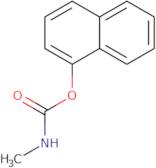Carbaryl
CAS: 63-25-2
Ref. 3D-FC19686
| 1g | Descontinuado | ||
| 2g | Descontinuado | ||
| 5g | Descontinuado | ||
| 10g | Descontinuado | ||
| 500mg | Descontinuado |
Informação sobre produto
- 1-Naphthyl N-methylcarbamate1-Naphthalenol methylcarbamate1-Naphtyl N-methylcarbamate
- 1-Naphthyl-N-methylcarbamate
- Adios
- Arilat
- Arilate
- Arylam
- Atoxan
- Bugmaster
- Caprolin
- Carbamec
- Ver mais sinónimos
- Carbamine
- Carbaril
- Carbatox
- Carbavur
- Carbomate
- Carpolin
- Carvin
- Carylderm
- Cekubaryl
- Clinicide
- Denapon
- Derbac
- Devicarb
- Dicarbam
- Dyna-carbyl
- Germain's
- Hexavin
- Karbaspray
- Karbatox
- Karbosep
- Laivin
- Menaphtam
- Methyl(Naphthalen-1-Yl)Carbamate
- Monsur
- Mugan
- Murvin
- NAC
- Oltitox
- Panam
- Patrin
- Pomex
- Prosevor
- Ravyon
- Savit
- Savite
- Seffein
- Septene
- Sevimol
- Sevin
- Sevin-4-Oil
- Sevnol
- Sewin
- Slam
- Suvamil
- Tercyl
- Thinsec
- Tornado
- Tricarnam
- Vetox
- Vioxan
- XLR-Plus
- 1-naphthalenol methylcarbamate
- 1-Naphthalenol, methylcarbamate
- Carbamic acid, methyl-, 1-naphthyl ester
- 1-Naphthalenol, 1-(N-methylcarbamate)
- Compound 7744
- naphthalen-1-yl methylcarbamate
- oms 29, uc 7744
- bug master
- 1-naphthyl methylcarbamate
- 1-naphthalenyl methylcarbamate
- 1-naphthol methylcarbamate
Carbaryl is an insecticide that inhibits the activity of acetylcholinesterase. This effect is due to its ability to bind tightly to the active site of the enzyme and form a covalent bond with the serine hydroxyl group. Carbaryl also has been shown to inhibit other enzymes, such as esterases, glutathione reductase, and cytochrome P450s. It has been used in vitro in assays that measure enzyme activities against various substrates (e.g., film, cardiac effects). Carbaryl is also used in wastewater treatment systems where it acts as a surfactant by reducing nitrite ion levels and lowering interfacial tension between water and air. In addition, carbaryl can also act as an energy metabolite because it contains a hydrophobic effect.





